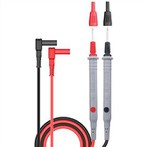How to quickly identify the positive and negative poles of the battery without a multimeter
Usually it is marked on the above, if it is not clear, just use a multimeter to measure it, use the DC voltage range, such as the range above 20 volts, connect the red test lead to one side, and the black test lead to the other side, if the display is positive voltage, It means that the red test pen corresponds to the positive pole, and the other end is the negative pole. If it shows negative voltage, it is reversed. If you don't have a multimeter, you can also use these wild methods to judge:
1. To distinguish from the color of the pole, the pole is brown for the positive pole, and the pole is gray for the negative pole.
2. Generally, the pole on the front of the brand on the battery shell is the positive pole, and the opposite is the negative pole.
3. After connecting with the surface terminals with wires, immerse in dilute sulfuric acid solution, the end with bubbles is the negative electrode, and the end without bubbles is the positive electrode.
4. Connect a light bulb to the two poles of the battery to form a circuit. Place a small magnetic needle under the wires that make up the loop. The direction pointed by the magnetic needle should be perpendicular to the direction of the wire at this time. Judging by the right-hand rule, the direction that the thumb points is the direction of current flow. Current flows from the battery positive terminal and back to the battery negative terminal.
5. Insert the two lead wires on the battery pole into the cut potato respectively. The green around the wire is the positive pole; the other pole is the negative pole.
6. Use a high-frequency discharger to detect and compare the two batteries, and the polarity of the end with the same response is the same. However, this trick requires a known polarity battery and a more professional discharger.
7. The thicker stigma is the + pole (positive pole), and the thinner stigma is the - pole (negative pole).
8. Use salt water to judge the positive and negative poles of the battery. Connect a wire to both ends of the battery, insert it into salt water, and check the wire ends. The end with more air bubbles is connected to the negative electrode of the battery, and the end with less air bubbles is connected to the positive electrode of the battery. There is one thing to note about this trick. The container holding the salt water must not be conductive. Generally, it is better to use a porcelain bowl. In addition, in addition to the commonly used salt water, alkaline water, dilute sulfuric acid, etc. can be used as long as they can be used as electrolytes.
9. There is copper sulfate solution in the beaker, close S, and after a few minutes of electrification, if red copper appears on the C carbon rod, then A is the positive pole and B is the negative pole; if red copper appears on the D carbon rod, then A is Negative pole, B is positive pole.
10. Light-emitting diode test method, if the light-emitting diode emits red light, then A is the positive pole and B is the negative pole; if the light-emitting diode does not emit light, then A is the negative pole and B is the positive pole.






